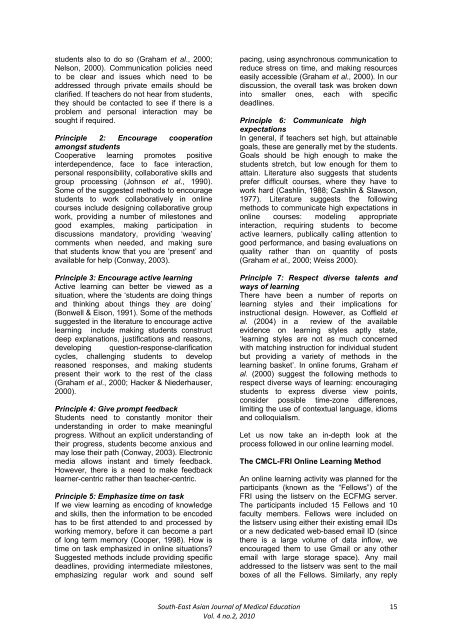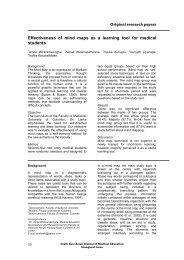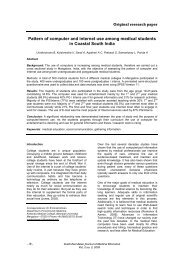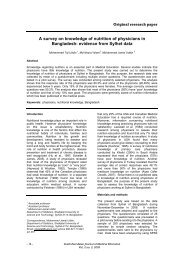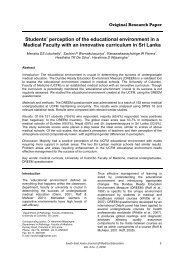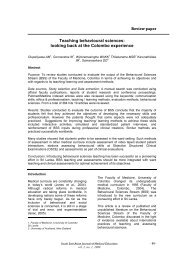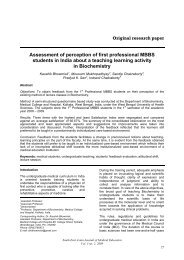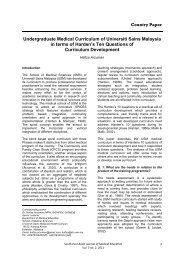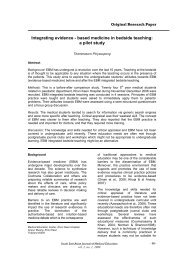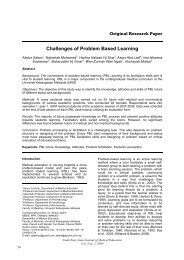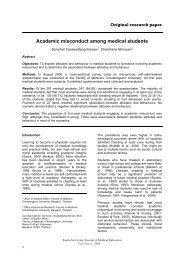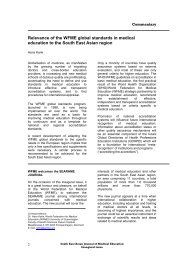Application of classroom good teaching practices to an online faculty ...
Application of classroom good teaching practices to an online faculty ...
Application of classroom good teaching practices to an online faculty ...
- No tags were found...
Create successful ePaper yourself
Turn your PDF publications into a flip-book with our unique Google optimized e-Paper software.
students also <strong>to</strong> do so (Graham et al., 2000;Nelson, 2000). Communication policies need<strong>to</strong> be clear <strong>an</strong>d issues which need <strong>to</strong> beaddressed through private emails should beclarified. If teachers do not hear from students,they should be contacted <strong>to</strong> see if there is aproblem <strong>an</strong>d personal interaction may besought if required.Principle 2: Encourage cooperationamongst studentsCooperative learning promotes positiveinterdependence, face <strong>to</strong> face interaction,personal responsibility, collaborative skills <strong>an</strong>dgroup processing (Johnson et al., 1990).Some <strong>of</strong> the suggested methods <strong>to</strong> encouragestudents <strong>to</strong> work collaboratively in <strong>online</strong>courses include designing collaborative groupwork, providing a number <strong>of</strong> miles<strong>to</strong>nes <strong>an</strong>d<strong>good</strong> examples, making participation indiscussions m<strong>an</strong>da<strong>to</strong>ry, providing ‘weaving’comments when needed, <strong>an</strong>d making surethat students know that you are ‘present’ <strong>an</strong>davailable for help (Conway, 2003).Principle 3: Encourage active learningActive learning c<strong>an</strong> better be viewed as asituation, where the ‘students are doing things<strong>an</strong>d thinking about things they are doing’(Bonwell & Eison, 1991). Some <strong>of</strong> the methodssuggested in the literature <strong>to</strong> encourage activelearning include making students constructdeep expl<strong>an</strong>ations, justifications <strong>an</strong>d reasons,developing question-response-clarificationcycles, challenging students <strong>to</strong> developreasoned responses, <strong>an</strong>d making studentspresent their work <strong>to</strong> the rest <strong>of</strong> the class(Graham et al., 2000; Hacker & Niederhauser,2000).Principle 4: Give prompt feedbackStudents need <strong>to</strong> const<strong>an</strong>tly moni<strong>to</strong>r theirunderst<strong>an</strong>ding in order <strong>to</strong> make me<strong>an</strong>ingfulprogress. Without <strong>an</strong> explicit underst<strong>an</strong>ding <strong>of</strong>their progress, students become <strong>an</strong>xious <strong>an</strong>dmay lose their path (Conway, 2003). Electronicmedia allows inst<strong>an</strong>t <strong>an</strong>d timely feedback.However, there is a need <strong>to</strong> make feedbacklearner-centric rather th<strong>an</strong> teacher-centric.Principle 5: Emphasize time on taskIf we view learning as encoding <strong>of</strong> knowledge<strong>an</strong>d skills, then the information <strong>to</strong> be encodedhas <strong>to</strong> be first attended <strong>to</strong> <strong>an</strong>d processed byworking memory, before it c<strong>an</strong> become a part<strong>of</strong> long term memory (Cooper, 1998). How istime on task emphasized in <strong>online</strong> situations?Suggested methods include providing specificdeadlines, providing intermediate miles<strong>to</strong>nes,emphasizing regular work <strong>an</strong>d sound selfpacing, using asynchronous communication <strong>to</strong>reduce stress on time, <strong>an</strong>d making resourceseasily accessible (Graham et al., 2000). In ourdiscussion, the overall task was broken downin<strong>to</strong> smaller ones, each with specificdeadlines.Principle 6: Communicate highexpectationsIn general, if teachers set high, but attainablegoals, these are generally met by the students.Goals should be high enough <strong>to</strong> make thestudents stretch, but low enough for them <strong>to</strong>attain. Literature also suggests that studentsprefer difficult courses, where they have <strong>to</strong>work hard (Cashlin, 1988; Cashlin & Slawson,1977). Literature suggests the followingmethods <strong>to</strong> communicate high expectations in<strong>online</strong> courses: modeling appropriateinteraction, requiring students <strong>to</strong> becomeactive learners, publically calling attention <strong>to</strong><strong>good</strong> perform<strong>an</strong>ce, <strong>an</strong>d basing evaluations onquality rather th<strong>an</strong> on qu<strong>an</strong>tity <strong>of</strong> posts(Graham et al., 2000; Weiss 2000).Principle 7: Respect diverse talents <strong>an</strong>dways <strong>of</strong> learningThere have been a number <strong>of</strong> reports onlearning styles <strong>an</strong>d their implications forinstructional design. However, as C<strong>of</strong>field etal. (2004) in a review <strong>of</strong> the availableevidence on learning styles aptly state,‘learning styles are not as much concernedwith matching instruction for individual studentbut providing a variety <strong>of</strong> methods in thelearning basket’. In <strong>online</strong> forums, Graham etal. (2000) suggest the following methods <strong>to</strong>respect diverse ways <strong>of</strong> learning: encouragingstudents <strong>to</strong> express diverse view points,consider possible time-zone differences,limiting the use <strong>of</strong> contextual l<strong>an</strong>guage, idioms<strong>an</strong>d colloquialism.Let us now take <strong>an</strong> in-depth look at theprocess followed in our <strong>online</strong> learning model.The CMCL-FRI Online Learning MethodAn <strong>online</strong> learning activity was pl<strong>an</strong>ned for theparticip<strong>an</strong>ts (known as the “Fellows”) <strong>of</strong> theFRI using the listserv on the ECFMG server.The particip<strong>an</strong>ts included 15 Fellows <strong>an</strong>d 10<strong>faculty</strong> members. Fellows were included onthe listserv using either their existing email IDsor a new dedicated web-based email ID (sincethere is a large volume <strong>of</strong> data inflow, weencouraged them <strong>to</strong> use Gmail or <strong>an</strong>y otheremail with large s<strong>to</strong>rage space). Any mailaddressed <strong>to</strong> the listserv was sent <strong>to</strong> the mailboxes <strong>of</strong> all the Fellows. Similarly, <strong>an</strong>y replySouth‐East Asi<strong>an</strong> Journal <strong>of</strong> Medical EducationVol. 4 no.2, 201015


